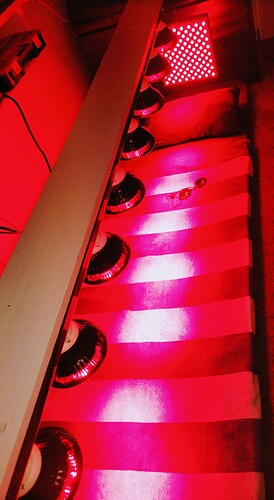Thank you, @Pattyg. We greatly appreciated you sharing your n=1 results. So to get these results are you using a 12”x12” 45W 660nm/850nm panel with 112 LEDs of each wavelength arranged in a grid, 6” away from your hands (or wherever your dark spots are/were) and eyebrows with the light generally hitting you straight-on (not at a major angle), for 6x per week at 20 minutes each session (120 minutes per week)? Do you stand facing your unit? Lie down? — I’d very much love to get your specific treatment so we all can compare to others (and the studies) and can decide what equipment may be needed for the impact we may seek.
Also, there is much written in the “studies” (with respect: most I’ve seen appear to have potential financial bias, for what it’s worth) concerning wrinkle decreases, skin roughness decreases, skin thickness decreases, skin rejuvenation, etc,). Have you seen any of these effects? — these are commonly suggested as “typical results”.
Supposedly 850nm will penetrate your skin (again, according to the “studies”, although heat penetrates the skin so there appears to potentially be some Far IR wavelengths that make it through, so why not Near IR) and increase mitochondrial function to provide more energy, soothe muscles, better sleep, less anxiety, better muscle recovery from exercise, and potentially other internal impacts. Have you experienced any of these impacts you have reason to believe is/are from these treatments?
I’m still very much game to try this: it’s cheap, non-invasive, difficult to “overdose”, doesn’t appear to have many negative effects with “overdose”, and if it works could be a positive with at least appearance, if it doesn’t work, I sat under a heating lamp for a month. Plus, I can sit still listening to a podcast for 20min a day. That is, if I can buy a cheap 45W panels and not a $1,200 system… However, I do hope there isn’t a “1+1=-1” impact with something else I’m doing, but until they run this in the ITP we’ll never know (that’s why they call it “bio hacking” and not “science”, and even that isn’t conclusive).
With regards to lasers versus LEDs, if precision and power isn’t required for the “treatment” and the underlying physiological effects are from that specific wavelength of light, LEDs should work fine (assuming the LEDs are as advertised with respect to power and specific wavelength). But I’d assume the “treatment” time (if this has been determined) of a laser would be far shorter than an LED panel (it simply has more power).

